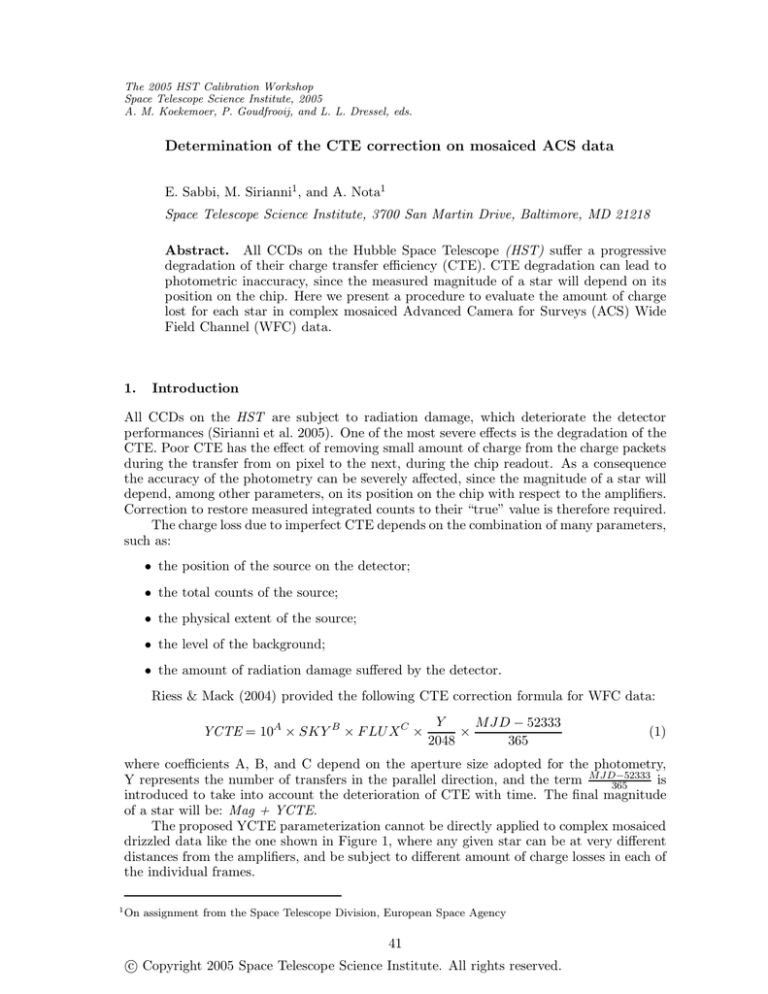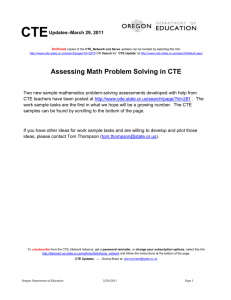
The 2005 HST Calibration Workshop
Space Telescope Science Institute, 2005
A. M. Koekemoer, P. Goudfrooij, and L. L. Dressel, eds.
Determination of the CTE correction on mosaiced ACS data
E. Sabbi, M. Sirianni1 , and A. Nota1
Space Telescope Science Institute, 3700 San Martin Drive, Baltimore, MD 21218
Abstract. All CCDs on the Hubble Space Telescope (HST) suffer a progressive
degradation of their charge transfer efficiency (CTE). CTE degradation can lead to
photometric inaccuracy, since the measured magnitude of a star will depend on its
position on the chip. Here we present a procedure to evaluate the amount of charge
lost for each star in complex mosaiced Advanced Camera for Surveys (ACS) Wide
Field Channel (WFC) data.
1.
Introduction
All CCDs on the HST are subject to radiation damage, which deteriorate the detector
performances (Sirianni et al. 2005). One of the most severe effects is the degradation of the
CTE. Poor CTE has the effect of removing small amount of charge from the charge packets
during the transfer from on pixel to the next, during the chip readout. As a consequence
the accuracy of the photometry can be severely affected, since the magnitude of a star will
depend, among other parameters, on its position on the chip with respect to the amplifiers.
Correction to restore measured integrated counts to their “true” value is therefore required.
The charge loss due to imperfect CTE depends on the combination of many parameters,
such as:
• the position of the source on the detector;
• the total counts of the source;
• the physical extent of the source;
• the level of the background;
• the amount of radiation damage suffered by the detector.
Riess & Mack (2004) provided the following CTE correction formula for WFC data:
YCTE = 10A × SKY B × F LU X C ×
Y
M JD − 52333
×
2048
365
(1)
where coefficients A, B, and C depend on the aperture size adopted for the photometry,
is
Y represents the number of transfers in the parallel direction, and the term M JD−52333
365
introduced to take into account the deterioration of CTE with time. The final magnitude
of a star will be: Mag + YCTE.
The proposed YCTE parameterization cannot be directly applied to complex mosaiced
drizzled data like the one shown in Figure 1, where any given star can be at very different
distances from the amplifiers, and be subject to different amount of charge losses in each of
the individual frames.
1
On assignment from the Space Telescope Division, European Space Agency
41
c Copyright 2005 Space Telescope Science Institute. All rights reserved.
42
Sabbi, Sirianni, & Nota
Figure 1: Mosaiced image of NGC 346. The three different pointings are shown. The
positions of the amplifiers for each pointing are marked (white dots).
2.
YCTE on mosaiced data
In order to derive the appropriate YCTE value for each star detected in Figure 1, we have
applied the following procedure.
1. Create a deep mosaic with multidrizzle by using the long exposure frames and a more
shallow one using the short exposures.
2. Star detection and PSF-fitting photometry were performed on the mosaiced images.
This procedure provides the most accurate magnitude (mag) determination for the
stars detected in the deep image.
3. Each individual frame was then corrected for geometric distortion and core aperture
photometry was performed on the detected stars. This allowed us to directly measure
the original integrated counts, still affected by the CTE losses.
4. YCTE correction was calculated for the photometry obtained on each single exposure,
by using Equation 1 (see Figure. 2).
5. All catalogs obtained from the aperture photometry were cross-correlated and for each
detected source the average value of YCTE ( < YCTE >) was computed for both
the long and the short exposures. The single exposures are affected by cosmic rays:
to obtain a clean determination of < YCTE > a sigma clipping on the associated
magnitude may be required (see Figure. 3).
6. The average correction was applied to the magnitude, measured at the first step, of
each star: M ag = mag+< YCTE >.
7. Given that the correction for YCTE for very faint stars is comparable to the photometric errors (see Figure. 4), stars too faint to be detected on the single exposures
were not corrected for CTE.
Determination of the CTE correction on mosaiced ACS data
43
Figure 2: CTE correction as a function of the position on the frame, for a single exposure
with an integration time of 3 sec (left panel) and with an integration time of 456 sec (right
panel)
Figure 3: CTE correction for the mosaiced image shown in Figure. 1
44
Sabbi, Sirianni, & Nota
Figure 4: CTE correction for a single exposure (with an integration time of 456 sec) as a
function of the photometric errors
References
Riess, A. & Mack, J. 2004, ACS Data Handbook, Sect. 6-17, available through
http://www.stsci.edu/hst/acs
Sirianni, M., et al. 2005, PASP, 117, 1049






